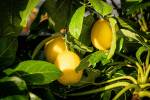If birds like your cactus fruit, you will, too
Q: I have Indian cacti and each year they grow flowers that have a bulb or fruit coming from the pads about 3 inches tall. I have been told that these bulbs make great jams. Is this true and, if so, can you tell me how to make this jam?
A: What you call the Indian cactus, we now more commonly call the nopal cactus because of its Mexican heritage. When nopal cactus pads are prepared as human food they are then called nopalitos.
Nopal cactus is harvested in Mexico for three purposes: fresh vegetable, fruits and animal or livestock feed. These plants are native to Central America, in particular the arid parts of Mexico and Central America, and are a staple part of diets. I might add nopal cactus has some great documented health benefits related to lowering high blood pressure, lowering the incidence of diabetes and providing a lot of dietary fiber.
Not all nopal cacti are the same in quality when used for fresh fruits and vegetables. Generally speaking if your nopal cactus is producing fruits but the birds are not devouring them when they are ripe, you will probably not like them either. However, if the birds love to devour these fruits, then you are in business.
There are selections of nopal cactus that are superior in these regards. I was growing two of these selections provided to me by faculty from the University of Sonora. These selections were nearly spineless.
But when you grow nopal cactus for food, you have to push their growth with frequent irrigations (every two weeks in the summer) and fertilizer and plant them with lots of compost. I will post more information on the nopal cactus and how to make this jam on my blog.
Q: It seems that whenever I try transplanting, I keep losing the plant. Mainly tomatoes and squash type plants. I've tried putting the plant in the area that it's going to get transplanted into for a few days and then making the move. I've tried boosting the area with fertilizers. Today, I tried to put up shade around the area so the direct light doesn't beat it up too bad. Do you have any advice?
A: If this was soil that was never planted in before and you don't see any weeds growing in the soil, then maybe there is a problem with the soil. Very seldom is it the case that our desert soils will grow nothing once they have been amended and irrigated.
It is more likely not enough soil preparation or the location is not the best for transplants. Vegetables need to be placed into desert soils that have had extensive modification prior to planting.
The modifications have to be ample amounts of compost and tillage to get the compost deep and provide for some drainage of water. I like to see at least 12 inches down and even 18 inches for deeply rooted vegetables like some carrots and other root crops.
I do prefer constructing raised beds for vegetables and herbs. The raised beds do not have to have side walls built from construction materials. The natural slope of the soils at the edges of a constructed bed will keep the bed from collapsing, provided you keep human traffic on it at a minimum.
But the soil must be ripped as deep as you can with a trencher or tractor, with water and good compost added to it and thorough mixing by tilling or rototilling.
The raised beds can be constructed by shoveling the soil, with compost added to it, onto a bed about 3-4 feet wide. Every time you plant for the first three years, you should be adding about 2 inches of compost to the bed and tilling or mixing it in with a tiller.
After about the first three years of adding extensive amounts of compost and growing in it, you will see your vegetable production reach a peak in yield and quality. After that then 1 inch is usually adequate.
Seldom have I seen transplants that were not acclimatized (putting them gradually outside from a greenhouse or nursery) just flat out die. They usually become stunted for awhile and then start to grow again.
Make sure transplants are planted the same depth in your garden as they were in the containers, if they are older plants. One exception is tomatoes, which can be planted deeper and the soil piled around the stems for a deeper root system, provided the soil has been prepared well.
Young, smaller plants transplant better than older, bigger plants and recover faster (usually).
Squash, melons, cucumbers and many other vegetables actually perform better if they are started in the garden from seed, not transplants.
Bob Morris is a horticulture expert living in Las Vegas; he is on special assignment in the Balkh Province, Afghanistan, for the University of California, Davis. Visit his blog at xtremehorticulture.blogspot.com.




























